How EU cities can localise SDGs through integrated action planning
Edited on
07 September 2022Global Goals For Cities Lead Expert Stina Heikkila shows URBACT cities taking steps to link local and global sustainability goals

The sense of urgency to transform our world is felt more strongly now than ever before, and towns and cities are at the heart of this global quest. With less than eight years to 2030, there is good reason to be excited about the results coming from the
Over the last 15 months, partners have identified gaps and priorities to be tackled in their cities in relation to the UN Sustainable Development Goals (SDGs), and are now preparing to co-create actions that will help reach their set objectives. The 19 participating cities delivered their draft Integrated Action Plans before summer
In this article, I share some of the action planning highlights so far, hoping to inspire other cities in Europe to embark on similar journeys. This strong focus on developing integrated actions for localising the SDGs is what makes this network unique in Europe and in the world. Enough talking, it is time for action!
19 cities – 19 unique SDG stories and ways to localise the SDGs
As a first step of the action planning process, partners worked on their visions for what their cities would look like in the future (by 2030 or another year, depending on the local context). This resulted in 19  G Stories’, with lots of diversity and creativity: seven videos, three “news from the future” articles, four infographics and seven narrative stories explaining the cities’ future visions. As an example, Klaipėda (LT) created an SDG story composed of a series of infographics explaining how the SDGs link to the city’s main strategic development plan, Klaipėda 2035, and how their Integrated Action Plan developed as part of the URBACT network will help to accelerate action.In Trim (IE), the SDG story was developed by involving local stakeholders in a ‘shopping’ activity, following an example from Marcoussis (FR) that URBACT Expert Christophe Gouache had presented to the network. In Trim, participants of the visioning exercise were given a certain amount in‘Truros’ – a fictional currency – and could shop for local priorities for the future, including the SDG targets, the five dimensions of the 2030 Agenda (People, Planet, Prosperity, Peace, Partnerships), as well as the challenges and priorities identified in the city profile at the start of the network journey. They also included petals from Rob Hopkins’ Imagination Sundial in the shop. The result was three priority areas for the future vision of Trim: a place for people; a safe, equitable and thriving place to live; and a sustainable, environmentally friendly town.
G Stories’, with lots of diversity and creativity: seven videos, three “news from the future” articles, four infographics and seven narrative stories explaining the cities’ future visions. As an example, Klaipėda (LT) created an SDG story composed of a series of infographics explaining how the SDGs link to the city’s main strategic development plan, Klaipėda 2035, and how their Integrated Action Plan developed as part of the URBACT network will help to accelerate action.In Trim (IE), the SDG story was developed by involving local stakeholders in a ‘shopping’ activity, following an example from Marcoussis (FR) that URBACT Expert Christophe Gouache had presented to the network. In Trim, participants of the visioning exercise were given a certain amount in‘Truros’ – a fictional currency – and could shop for local priorities for the future, including the SDG targets, the five dimensions of the 2030 Agenda (People, Planet, Prosperity, Peace, Partnerships), as well as the challenges and priorities identified in the city profile at the start of the network journey. They also included petals from Rob Hopkins’ Imagination Sundial in the shop. The result was three priority areas for the future vision of Trim: a place for people; a safe, equitable and thriving place to live; and a sustainable, environmentally friendly town.
Moving from vision to action: a mission-inspired approach
Having developed their SDG stories, the next step for cities is to start defining concrete actions to deliver their vision.
When co-creating actions together with local stakeholders, one common challenge is to ensure actions are realistic and achievable. Another is how to avoid working in silos with sectoral priorities. The SDGs provide a holistic framework, and should not be seen as 17 separate goals to be tackled one-by-one. But how do you start concrete actions without losing sight of the indivisible nature of the goals, and while remaining selective and strategic?
Part of the answer lies in the integrated approach promoted by URBACT, fostering horizontal, vertical and territorial integration. The Integration Assessment Grid, for example, helps to ensure that cities consider different types of integration in their action plan.
In addition, defining clear and cross-cutting priorities helps partners to set the direction for what is to be achieved together with their local stakeholders.
To do this, we gained inspiration from the ‘mission-oriented approach’ developed by the economist Mariana Mazzucato, and used by the European Commission to set its five EU missions for the 2021-2027 programming period (a novelty of the Horizon Europe research and innovation programme), including the one that focuses on achieving 100 Climate-Neutral and Smart Cities by 2030.
What is a mission-oriented approach, and why is it useful for cities defining SDG actions?
Missions can be seen as bold goals of societal relevance that “catalyse investment and innovation from many different sectors and inspire new collaborations at the project level” (Mazzucato, 2020). The idea behind missions is first to ask: “What is the problem we want to solve?” and then define a mission that sets the shared direction towards solving it, through a clear goal and multiple potential paths and partnerships to achieve it. While the approach has been principally applied in the science, technology and innovation (STI) policy domain, in its more recent and broader applications “missions are a pathway towards different ways of working across the public sector and creating better public value for citizens” (OECD, 2021).
For the Global Goals for Cities network
“an overarching societal goal that brings together multiple actors to focus on solving a cross-sectoral problem, within a given time frame”.
For our purposes, a mission is more specific than the vision (in our case the SDG stories), which describes the desirable future situation in broad terms. Yet, missions are cross-cutting enough to go beyond single objectives or SDGs, promoting an integrated approach. One of the main motivations for using missions is to tackle different inter-connected SDGs under one umbrella while giving a clear and shared direction. At the same time, the mission-oriented approach reinforces the intervention logic that is part of the URBACT method, and is in line with goal-based planning called for by the SDGs. The examples below illustrate what this means in practice.
Five steps for cities to move from visioning their SDG stories to defining missions
Global Goals for Cities partners used a new tool to stimulate collective reflection around the question “What’s the problem we want to solve?”. The ‘Vision Wheel’ – shown below – introduces a five step process for moving from vision to setting missions, starting by putting the vision in the centre of the circle. After listing the thematic areas covered by the vision (the petals around the core), the different segments of the wheel are filled from the outside in, following five clear steps:
- identify how the vision’s themes link to different SDGs;
- pin-point the most relevant targets under those SDGs;
- identify the key stakeholders involved in delivering the vision;
- map existing initiatives linked to the vision and its themes, and;
- connect the dots across different themes, existing initiatives, key stakeholders, and SDGs to find cross-cutting missions that can be agreed among stakeholders.
The zoomed-in section below the empty tool illustrates what a filled out wheel may look like.
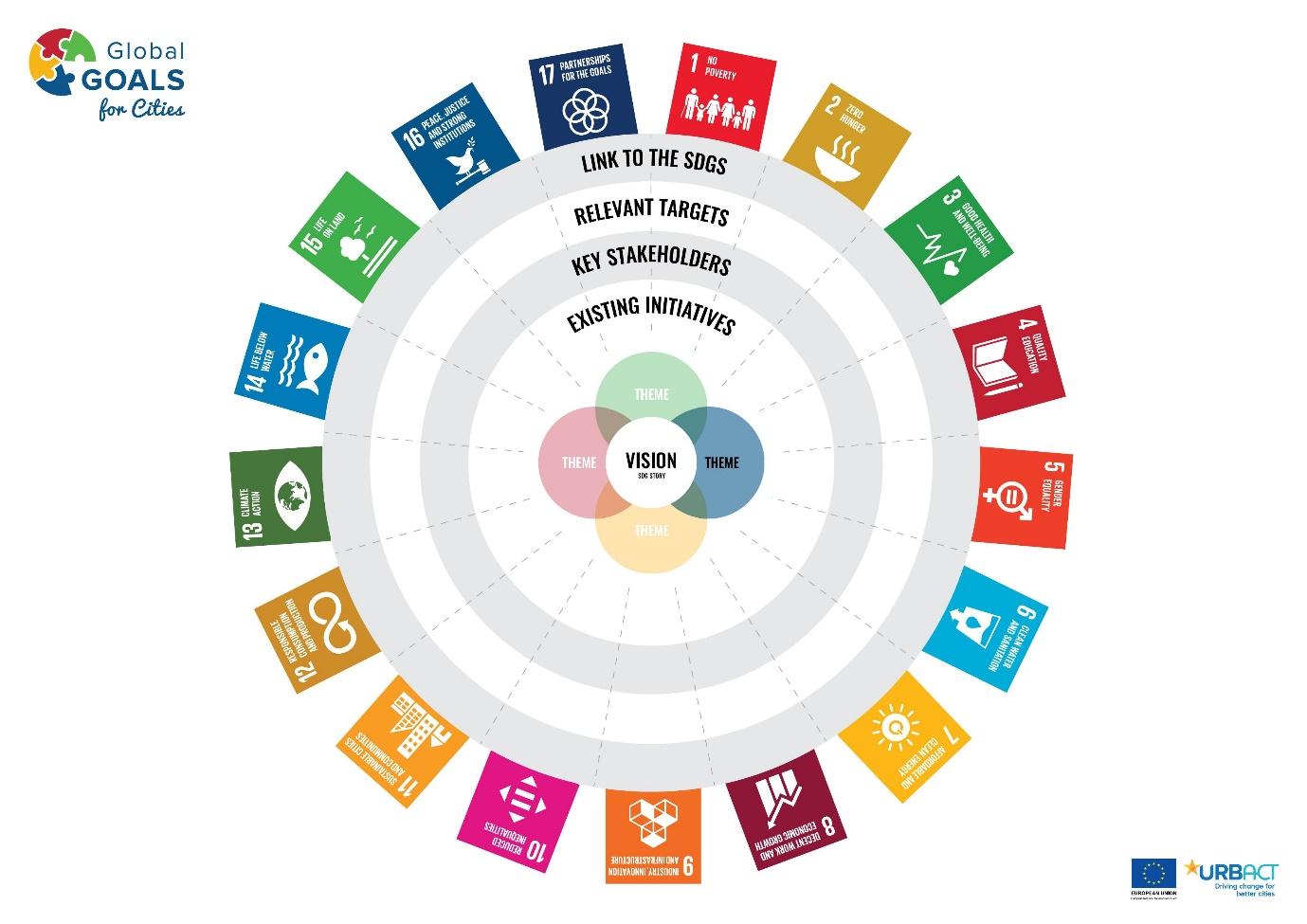
A Zoomed-in section of a pre-filled Vision Wheel, showing how the different themes of the vision in the centre map to different SDGs.
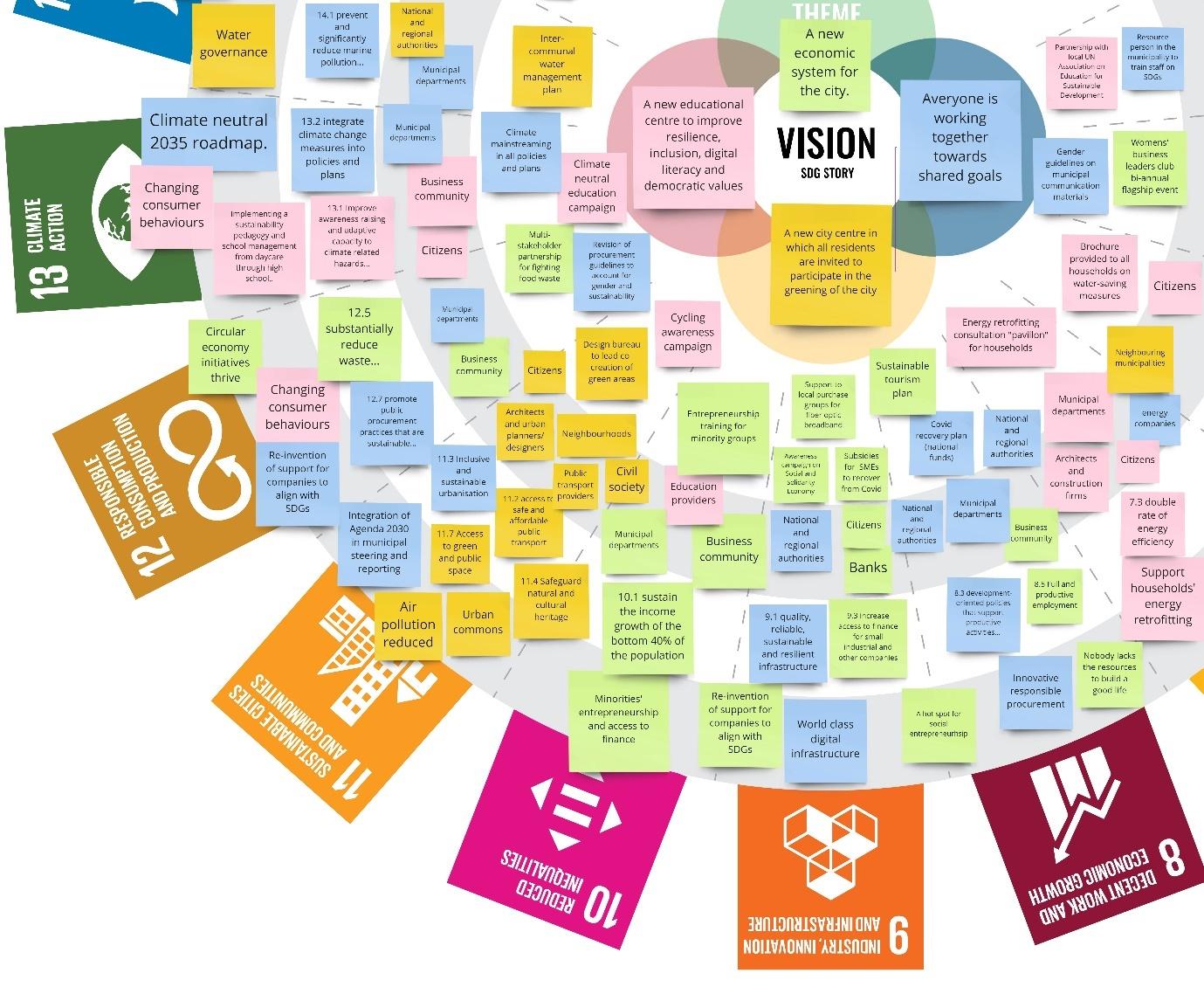
The Vision Wheel mapping exercise allows participants to perceive the complexity of the strategic and operative landscape of a city - the filled wheel tends to get quite messy! By mapping the ‘system’ of interlinked initiatives, stakeholders and goals, the Vision Wheel helps to spot gaps and strategic connections across sectors and fields of activity that may otherwise not have been explored.
Bringing down silos
One key advantage of the Vision Wheel is therefore that it helps bring down policy silos. For example, could the revision of the municipality’s procurement guidelines (SDG12) be revised to stimulate social entrepreneurship and innovation (SDG9, SDG8) potentially helping people who are far from the labour market (SDG10) or promote gender equality (SDG5)? Can entrepreneurs partner up with the municipality (SDG 17) to deliver carbon neutrality (SDG 13)?
Could working on enhancing biodiversity in the city’s green spaces (SDG 15) be linked to mental health programmes (SDG 3), school gardens (SDG 2) and participation in urban design (SDG11)? Could the city’s carbon neutrality plan (SDG 13) become a key lever for promoting multi-functional green spaces and reduce inequalities in well-being (SDG 10)? Which actors are already involved, and are they willing to contribute to a shared mission (SDG 17)? These are some of the questions asked during this exercise.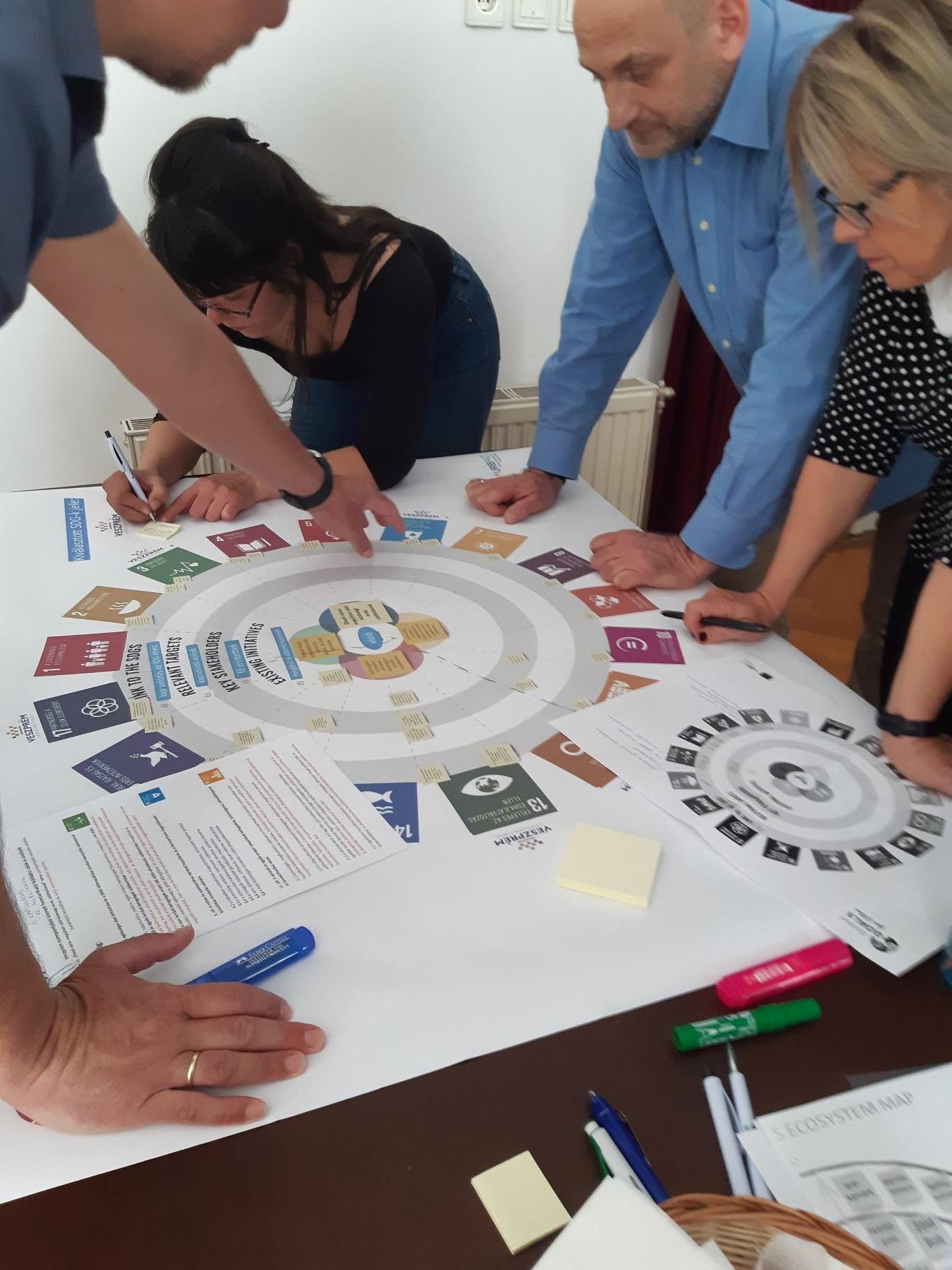
In Veszprém (HU), the result of carrying out this collective intelligence practice was a mission combining sustainable water management (SDG 6), multi-functional green spaces (SDGs 15 and 13), natural and built heritage (SDG 11), health (SDG 3) and community involvement (SDGs 11 and 17). It was derived from their SDG story’s four themes: sustainable mobility, sustainable water management, green spaces and community engagement.
Putting the Integrated Action Plan together: aligning ‘SMART’ objectives with SDG targets and actions
After identifying their missions, Global Goals for Cities partners continue to set out the details of their SDG localisation work.
The next step is to build a monitoring framework for their Integrated Action Plans – defining ‘SMART’ (Specific, Measurable, Achievable, Realistic, Time-bound) objectives and identifying measurable results – and to link these to the SDG framework.
To do this, the ‘Integrated Action Plan Canvas’ shows how the different pieces of the puzzle fit together. Reading the canvas from the upper right, the vision leads to defining cross-cutting missions, as explained above, which in turn are linked to relevant SDGs and targets.
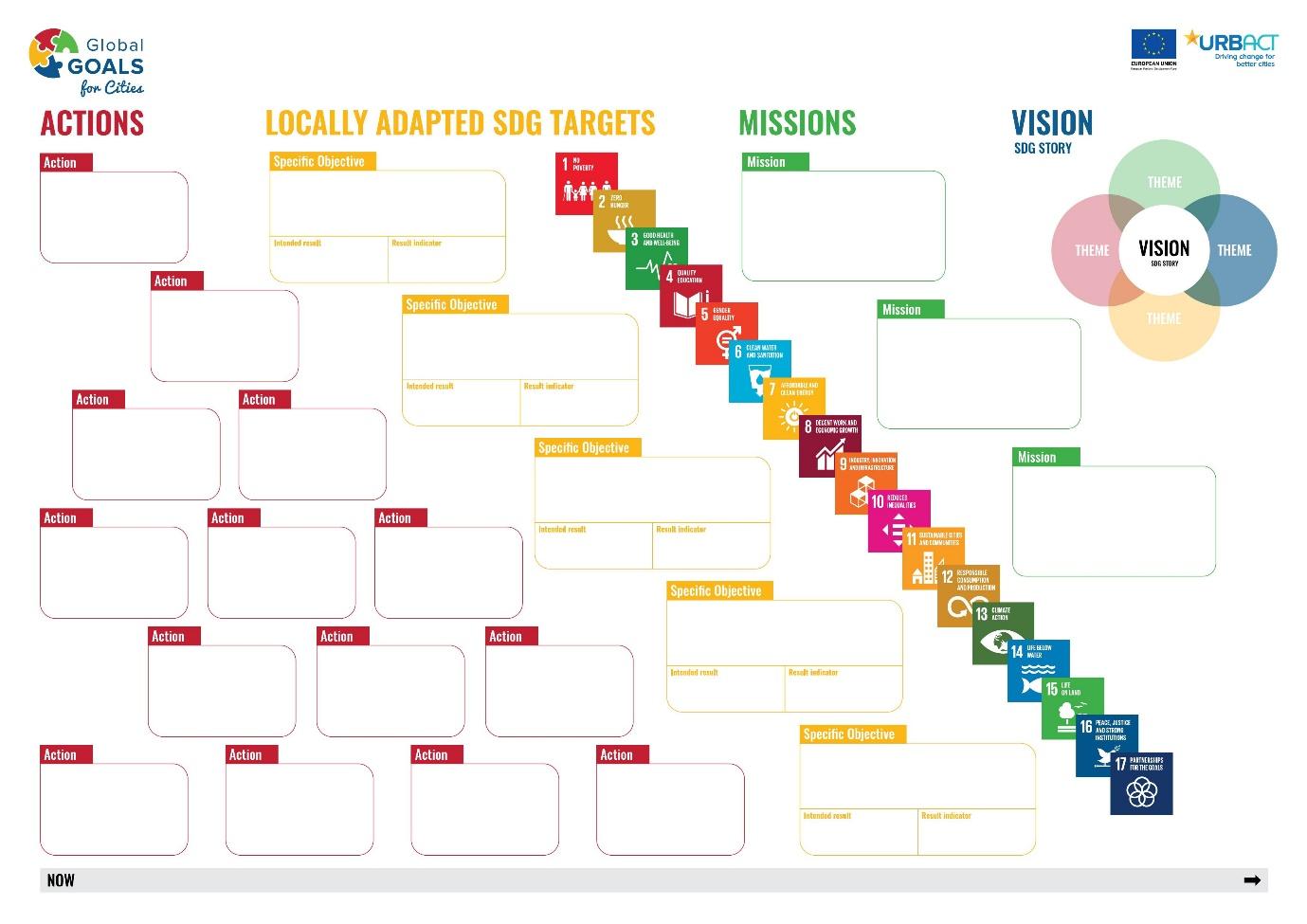
In the yellow segment of the canvas are the so-called ‘Locally adapted SDG targets’ and specific objectives. This illustrates that the specific objectives are derived from (or are at least within the same scope as) the official SDG targets formulated in the global framework. That is how partners can claim to be working towards the global goals (the devil is in the details…).
The
Two examples of how SDG targets are localised
- Veszprém: linking local missions to Sustainable Development Goals 6 and 17 and beyond
Coming back to the example of Veszprém, we saw above how their mission is linked to several SDGs. Under those SDGs, the local team has identified Specific Objectives that are in line with relevant SDG targets, adapted to the local level. Two illustrative examples are set out below, both still works in progress.

The above examples illustrate the main SDG target that is being localised and impacted by the action: the one that will be measured at the results level following a clear intervention logic. In the detailed Action Tables, other relevant targets are also identified to highlight the interconnected nature
- 15.1
E nsuring the conservation, restoration and sustainable use of terrestrial and freshwater ecosystems and their services, in particular forests, wetlands, mountains and dry habitats, in accordance with obligations under international agreements; - 13.1 Strengthening resilience and adaptation to climate change-related hazards and natural disasters
; - 12.2 Achieving sustainable management and efficient use of natural resources.
For the action aimed at community planning, the following targets are identified as relevant:
- 11.3 By 2030, enhance inclusive and sustainable urbani
s ation and capacity for participatory, integrated and sustainable human settlement planning and management; - 16.7
E nsure responsive, inclusive, participatory and representative decision-making at all levels; - 5.5
E nsure women’s full and effective participation and equal opportunities for leadership at all levels of decision-making in political, economic, and public life; - 10.2
B y 2030 empower and promote the social, economic and political inclusion of all irrespective of age, sex, disability, race, ethnicity, origin, religion or economic or other status.
2. Gävle: linking local missions to Sustainable Development Goal 17.14
In Gävle, the approach taken is slightly different. Focus here is on strengthening governance aspects of implementing the 2030 Agenda locally. The mission defined by Gävle (SE) in its Integrated Action Plan reads: 'By 2030, Gävle municipality will achieve a holistic perspective on sustainable development by increasing knowledge and collaboration between municipal organizations, residents, associations and businesses'.
This is derived from the broader vision of 'Collaborating to create the Good Life in Gävle', by working holistically across the municipality’s three strategic programmes for ecological, social and economic sustainability.
The scope of Gävle’s Integrated Action Plan is hence to build on the municipality’s long tradition of integrated sustainable urban development and to continue to reinforce the 2030 Agenda and the SDGs as a shared framework.
The locally adapted SDG target in main focus is SDG 17.14: enhance policy coherence for sustainable development. Other goals are operationalised through the three strategic programmes, ensuring a holistic approach.
The two examples below illustrate how different governance and management actions contribute to the municipality’s SMART objectives, within the scope of target 17.14.
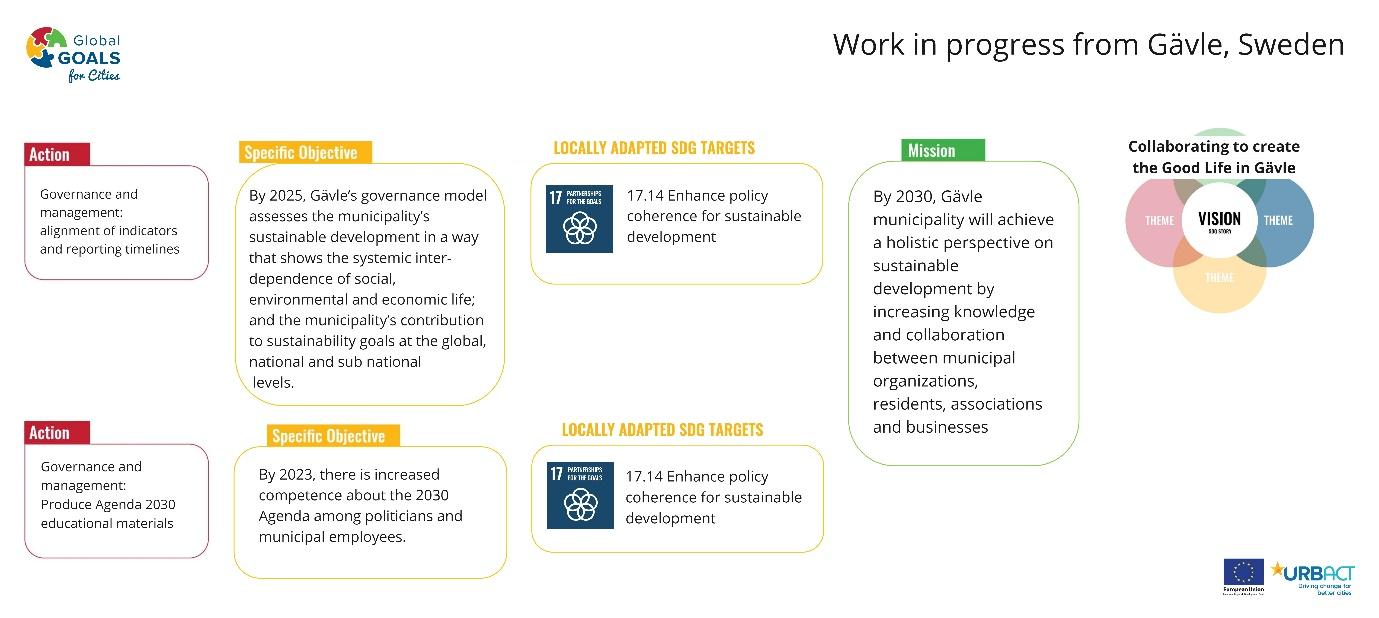
Next step: results indicators
The next challenge for Global Goals for Cities partners will be to identify results indicators to match their specific objectives and localised SDG targets. This is far from straightforward, since data can be sparse at the local level, and there is a need to remain relevant locally while also adhering to the SDG framework and enabling international comparisons.
To support this work, a core set of around 50 local indicators were presented to our cities by URBACT Expert Eleni Feleki, based on her research on indicators for measuring urban sustainability, which can also be used for measuring progress on the SDGs at local level. We further compared and presented other existing frameworks developed by leading organisations such as the European Commission’s Joint Research Centre (JRC), the Organisation for Economic Co-operation and Development (OECD), and the Council of European Municipalities and Regions (CEMR), as well as from the meeting’s co-host cities Reggio Emilia (IT) and Gävle (SE).
Work on identifying indicators is
Moving forward: six peer groups based on cities’ SDG localisation approach
In answer to feedback given at the network’s mid-term reflection, we have divided cities into four broad categories, based on their overall approach towards localising the SDGs. Within these peer groups, partners will work in groups of two to three
- The Strategi
s ers. These are partners who are working on an Integrated Action Plans that will serve to operationalise their cities’ comprehensive, long-term city strategies. In these cases, strategic documents are being finalised in parallel to the GG4C network activities, and therefore the action planning steps fit well into the process. - The Pioneers. These peer groups are among the first municipalities in their countries to work on SDG localisation in a comprehensive way. As such, they become leading examples, applying the URBACT method to SDG localisation from start to finish.
- The Locals. These peers are those who have been working out their priorities for the Integrated Action Plans closely with local stakeholders bottom-up. At the same time, their Integrated Action Plans will fit into the existing strategic landscape of the municipality in different ways.
- The Intrapreneurs. These partners make a bet on changing the city’s governance towards one that is guided by the SDGs. For example, introducing SDG localisation guidelines or shared indicators for the whole municipal organisation is in focus. These partners tend to focus on processes to strengthen policy coherence for sustainable development in their local contexts (like in the case of Gävle above).
 The peer groups are now starting to review each other’s draft Integrated Action Plans, and will work on their drafts together in our eighth transnational meeting in Braga in September 2022. The final products will be ready by the end of 2022.
The peer groups are now starting to review each other’s draft Integrated Action Plans, and will work on their drafts together in our eighth transnational meeting in Braga in September 2022. The final products will be ready by the end of 2022.
In short, the cities in our network keep up good energy and momentum. We all understand that in the end, trying to transform our world is no small feat!
Find out more:
Read our news story from two eventful months of June and July 2022: https://urbact.eu/global-goals-cities-network-connects-europe-and-world-push-accelerate-delivery-sdgs
Read Gävle’s (SE) insights from our latest transnational meeting, hosted in Gävle, 23-25 May 2022: https://urbact.eu/g%C3%A4vles-insight-latest-tm7
Read Reggio Emilia’s (IT) insights as co-hosts of the meeting: https://urbact.eu/insights-reggio-emilia-co-host-tm7
 Submitted by Stina Heikkila on
Submitted by Stina Heikkila on
